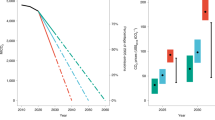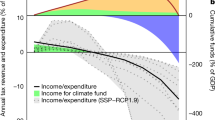Abstract
Economic theory suggests that comprehensive carbon pricing is most efficient to reach ambitious climate targets1, and previous studies indicated that the carbon price required for limiting global mean warming to 2 °C is between US$16 and US$73 per tonne of CO2 in 2015 (ref. 2). Yet, a global implementation of such high carbon prices is unlikely to be politically feasible in the short term. Instead, most climate policies enacted so far are technology policies or fragmented and moderate carbon pricing schemes. This paper shows that ambitious climate targets can be kept within reach until 2030 despite a sub-optimal policy mix. With a state-of-the-art energy–economy model we quantify the interactions and unique effects of three major policy components: (1) a carbon price starting at US$7 per tonne of CO2 in 2015 to incentivize economy-wide mitigation, flanked by (2) support for low-carbon energy technologies to pave the way for future decarbonization, and (3) a moratorium on new coal-fired power plants to limit stranded assets. We find that such a mix limits the efficiency losses compared with the optimal policy, and at the same time lowers distributional impacts. Therefore, we argue that this instrument mix might be a politically more feasible alternative to the optimal policy based on a comprehensive carbon price alone.
This is a preview of subscription content, access via your institution
Access options
Subscribe to this journal
Receive 12 print issues and online access
$209.00 per year
only $17.42 per issue
Buy this article
- Purchase on Springer Link
- Instant access to full article PDF
Prices may be subject to local taxes which are calculated during checkout




Similar content being viewed by others
References
Goulder, L. H. & Parry, I. W. H. Instrument choice in environmental policy. Rev. Environ. Econ. Policy 2, 152–174 (2008).
IPCC Climate Change 2014: Mitigation of Climate Change (eds Edenhofer, O. et al.) (Cambridge Univ. Press, 2014).
Kriegler, E. et al. What does the 2 °C target imply for a global climate agreement in 2020? The LIMITS study on Durban Platform scenarios. Clim. Change Econ. 04, 1–30 (2013).
Riahi, K. et al. Locked into Copenhagen pledges — Implications of short-term emission targets for the cost and feasibility of long-term climate goals. Technol. Forecast. Soc. Change 90, 8–23 (2015).
Luderer, G. et al. Economic mitigation challenges: How further delay closes the door for achieving climate targets. Environ. Res. Lett. 8, 034033 (2013).
Luderer, G., Bertram, C., Calvin, K., Cian, E. D. & Kriegler, E. Implications of weak near-term climate policies on long-term mitigation pathways. Climatic Change 1–14 (2013).
Rogelj, J., McCollum, D. L., Reisinger, A., Meinshausen, M. & Riahi, K. Probabilistic cost estimates for climate change mitigation. Nature 493, 79–83 (2013).
The Emissions Gap Report 2014 (United Nations Environment Programme (UNEP), 2014).
Den Elzen, M. G. J., Hof, A. F. & Roelfsema, M. The emissions gap between the Copenhagen pledges and the 2 °C climate goal: Options for closing and risks that could widen the gap. Glob. Environ. Change 21, 733–743 (2011).
Blanford, G. J., Kriegler, E. & Tavoni, M. Harmonization vs. fragmentation: Overview of climate policy scenarios in EMF27. Climatic Change 123, 383–396 (2014).
Kriegler, E. et al. Making or breaking climate targets: The AMPERE study on staged accession scenarios for climate policy. Technol. Forecast. Soc. Change 90, 24–44 (2015).
Grubb, M., Chapuis, T. & Duong, M. H. The economics of changing course: Implications of adaptability and inertia for optimal climate policy. Energy Policy 23, 417–431 (1995).
Bertram, C. et al. Carbon lock-in through capital stock inertia associated with weak near-term climate policies. Technol. Forecast. Soc. Change 90, 62–72 (2015).
Bauer, N., Baumstark, L. & Leimbach, M. The REMIND-R model: The role of renewables in the low-carbon transformation—first-best vs. second-best worlds. Climatic Change 114, 145–168 (2012).
Jaffe, A. B., Newell, R. G. & Stavins, R. N. A tale of two market failures: Technology and environmental policy. Ecol. Econ. 54, 164–174 (2005).
Bennear, L. S. & Stavins, R. N. Second-best theory and the use of multiple policy instruments. Environ. Resour. Econ. 37, 111–129 (2007).
Kalkuhl, M., Edenhofer, O. & Lessmann, K. Renewable energy subsidies: Second-best policy or fatal aberration for mitigation? Resour. Energy Econ. 35, 217–234 (2013).
Weitzman, M. L. Prices vs. quantities. Rev. Econ. Stud. 41, 477–491 (1974).
Requate, T. & Unold, W. Environmental policy incentives to adopt advanced abatement technology: Will the true ranking please stand up? Eur. Econ. Rev. 47, 125–146 (2003).
Goulder, L. H. & Schein, A. Carbon Taxes vs. Cap and Trade: A Critical Review (National Bureau of Economic Research, 2013).
Leimbach, M., Bauer, N., Baumstark, L. & Edenhofer, O. Mitigation costs in a globalized world: Climate policy analysis with REMIND-R. Environ. Model. Assess. 15, 155–173 (2010).
Bauer, N., Brecha, R. J. & Luderer, G. Economics of nuclear power and climate change mitigation policies. Proc. Natl Acad. Sci. USA 109, 16805–16810 (2012).
Den Elzen, M., Roelfsema, M., Hof, A. F., Böttcher, H. & Grassi, G. Analysing the Emission Gap Between Pledged Emission Reductions Under the Cancún Agreements and the 2 °C Climate Target (PBL/IIASA/JRC, 2012).
Kriegler, E. et al. The role of technology for achieving climate policy objectives: Overview of the EMF 27 study on global technology and climate policy strategies. Climatic Change 123, 353–367 (2014).
Krey, V., Luderer, G., Clarke, L. & Kriegler, E. Getting from here to there—energy technology transformation pathways in the EMF27 scenarios. Climatic Change 123, 369–382 (2014).
Pietzcker, R. C. et al. Long-term transport energy demand and climate policy: Alternative visions on transport decarbonization in energy-economy models. Energy 64, 95–108 (2014).
Marschinski, R., Flachsland, C. & Jakob, M. Sectoral linking of carbon markets: A trade-theory analysis. Resour. Energy Econ. 34, 585–606 (2012).
Fischer, C. & Newell, R. G. Environmental and technology policies for climate mitigation. J. Environ. Econ. Manage. 55, 142–162 (2008).
Schwanitz, V. J., Piontek, F., Bertram, C. & Luderer, G. Long-term climate policy implications of phasing out fossil fuel subsidies. Energy Policy 67, 882–894 (2014).
Schaeffer, M. et al. Mid- and long-term climate projections for fragmented and delayed-action scenarios. Technol. Forecast. Soc. Change 90, 257–268 (2015).
Acknowledgements
The research leading to these results has received funding from the European Union’s Seventh Framework Programme (FP7/2007-2013) under grant agreement no. 308329 (ADVANCE).
Author information
Authors and Affiliations
Contributions
C.B. and G.L. designed the research with input by R.C.P., E.K. and O.E.; C.B. performed the modelling and data analysis; C.B. wrote the paper with contributions and edits by all authors.
Corresponding author
Ethics declarations
Competing interests
The authors declare no competing financial interests.
Supplementary information
Rights and permissions
About this article
Cite this article
Bertram, C., Luderer, G., Pietzcker, R. et al. Complementing carbon prices with technology policies to keep climate targets within reach. Nature Clim Change 5, 235–239 (2015). https://doi.org/10.1038/nclimate2514
Received:
Accepted:
Published:
Issue Date:
DOI: https://doi.org/10.1038/nclimate2514
This article is cited by
-
The role of the IPCC in assessing actionable evidence for climate policymaking
npj Climate Action (2024)
-
Coal-exit alliance must confront freeriding sectors to propel Paris-aligned momentum
Nature Climate Change (2023)
-
Heterogeneous effects of battery storage deployment strategies on decarbonization of provincial power systems in China
Nature Communications (2023)
-
Expanding climate policy adoption improves national mitigation efforts
npj Climate Action (2023)
-
The effect of carbon price on low carbon innovation
Scientific Reports (2023)



